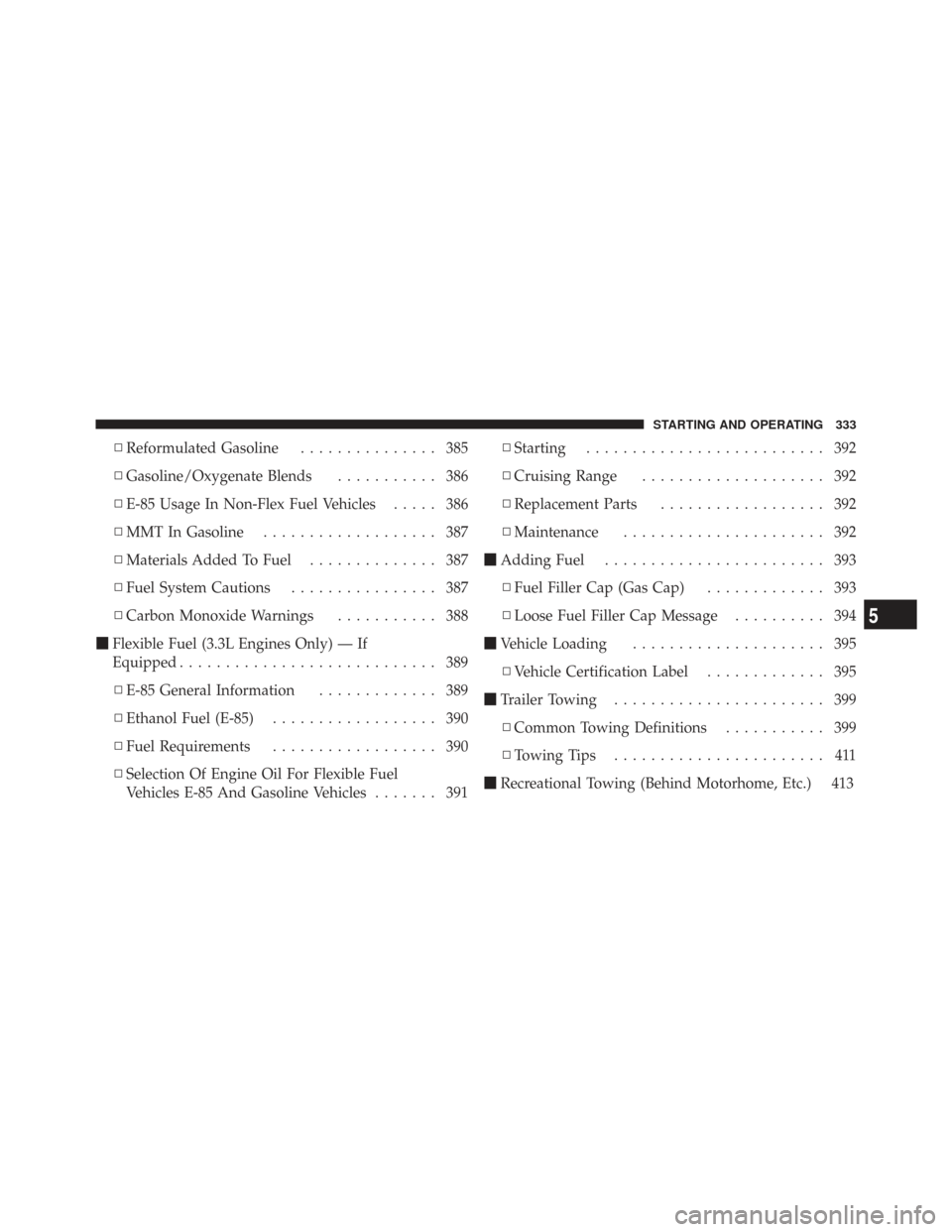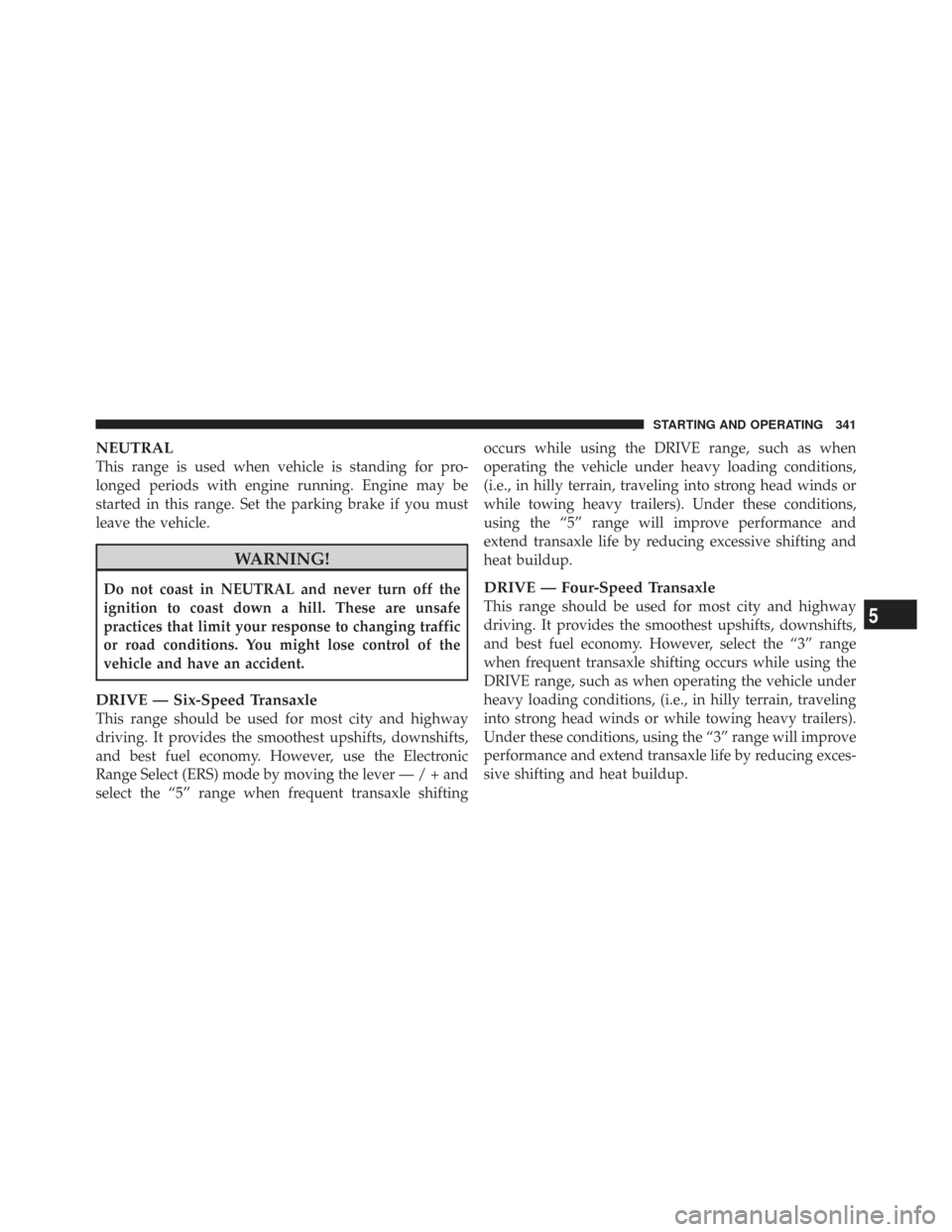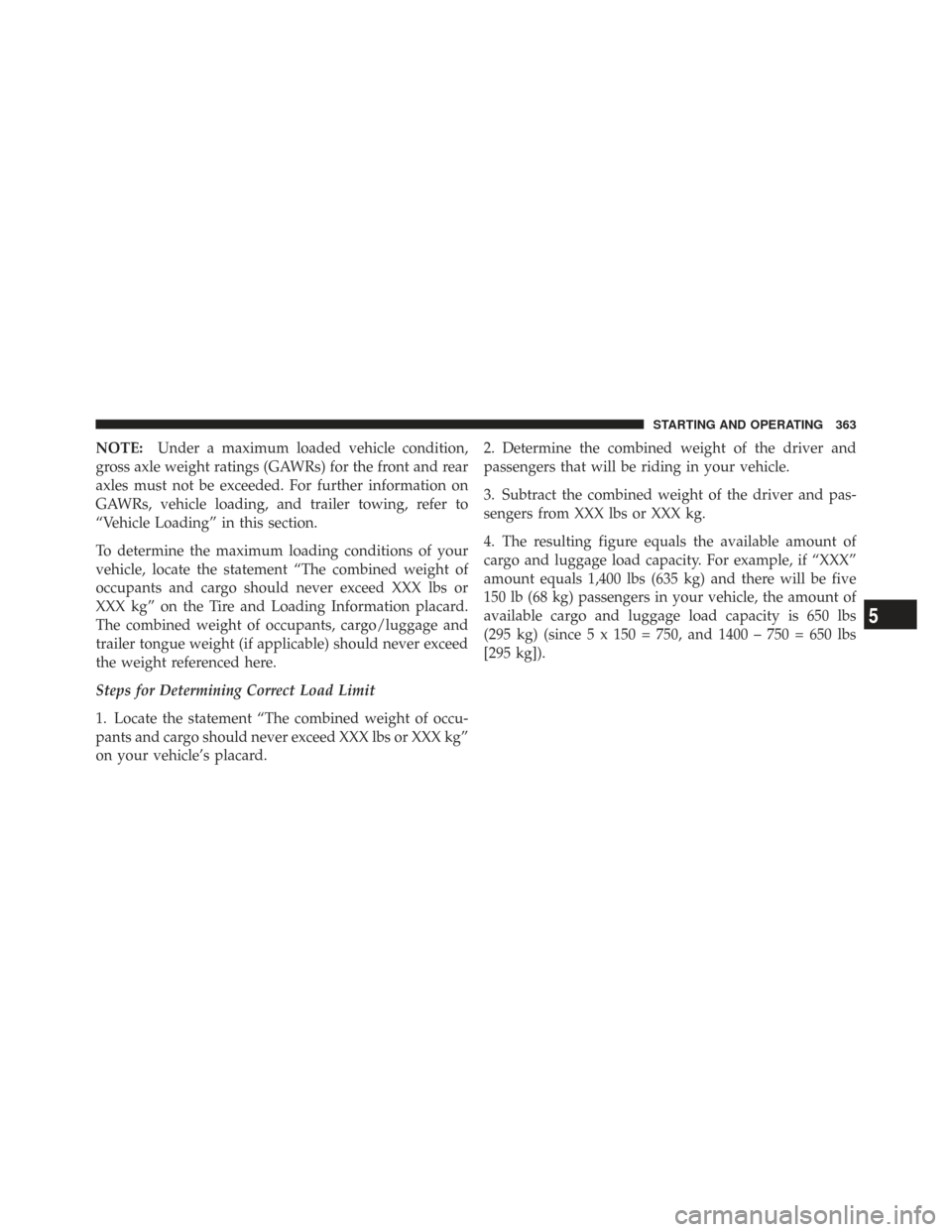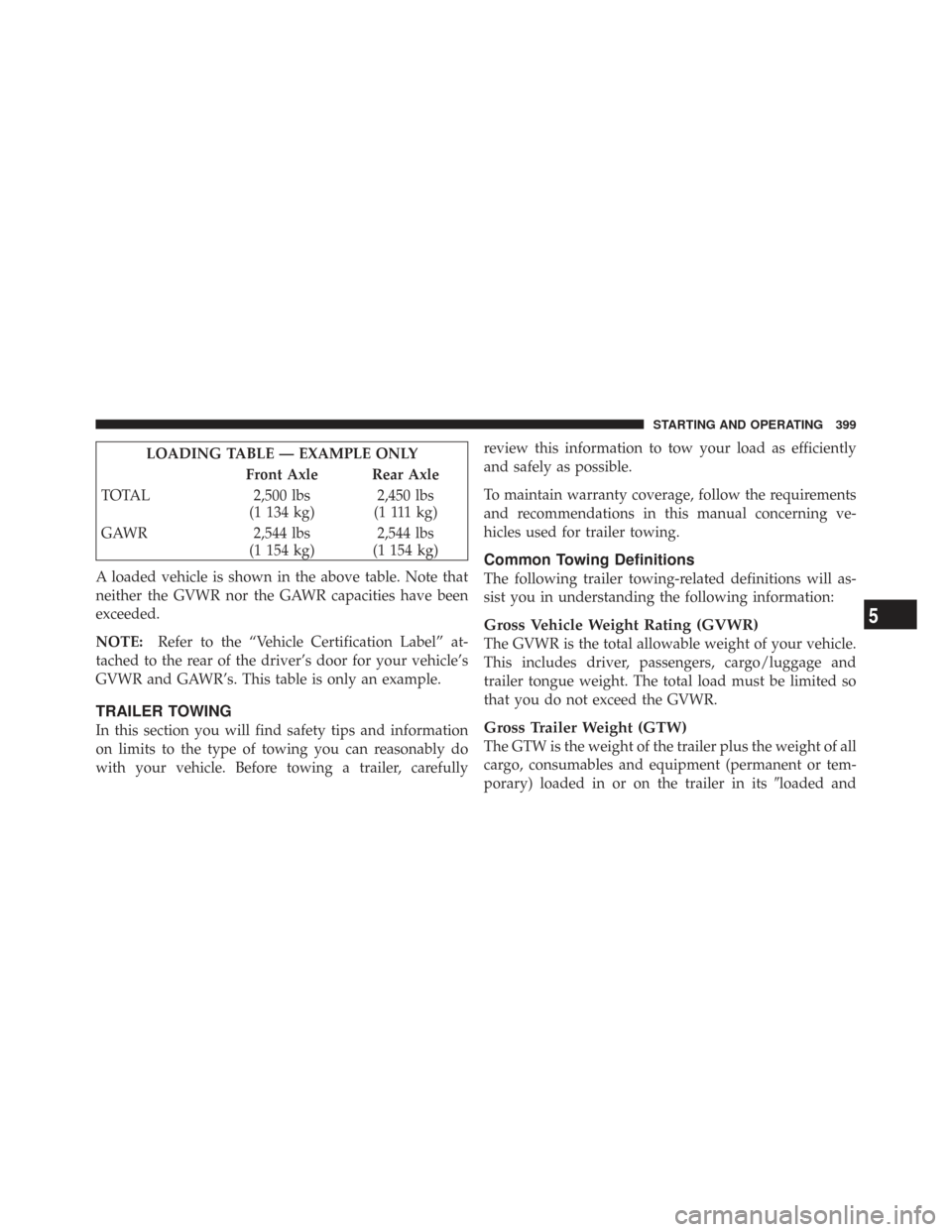Page 335 of 543

▫Reformulated Gasoline ............... 385
▫ Gasoline/Oxygenate Blends ........... 386
▫ E-85 Usage In Non-Flex Fuel Vehicles ..... 386
▫ MMT In Gasoline ................... 387
▫ Materials Added To Fuel .............. 387
▫ Fuel System Cautions ................ 387
▫ Carbon Monoxide Warnings ........... 388
� Flexible Fuel (3.3L Engines Only) — If
Equipped ............................ 389
▫ E-85 General Information ............. 389
▫ Ethanol Fuel (E-85) .................. 390
▫ Fuel Requirements .................. 390
▫ Selection Of Engine Oil For Flexible Fuel
Vehicles E-85 And Gasoline Vehicles ....... 391▫
Starting .......................... 392
▫ Cruising Range .................... 392
▫ Replacement Parts .................. 392
▫ Maintenance ...................... 392
� Adding Fuel ........................ 393
▫ Fuel Filler Cap (Gas Cap) ............. 393
▫ Loose Fuel Filler Cap Message .......... 394
� Vehicle Loading ..................... 395
▫ Vehicle Certification Label ............. 395
� Trailer Towing ....................... 399
▫ Common Towing Definitions ........... 399
▫ Towing Tips ....................... 411
� Recreational Towing (Behind Motorhome, Etc.) 413
5
STARTING AND OPERATING 333
Page 343 of 543

NEUTRAL
This range is used when vehicle is standing for pro-
longed periods with engine running. Engine may be
started in this range. Set the parking brake if you must
leave the vehicle.
WARNING!
Do not coast in NEUTRAL and never turn off the
ignition to coast down a hill. These are unsafe
practices that limit your response to changing traffic
or road conditions. You might lose control of the
vehicle and have an accident.
DRIVE — Six-Speed Transaxle
This range should be used for most city and highway
driving. It provides the smoothest upshifts, downshifts,
and best fuel economy. However, use the Electronic
Range Select (ERS) mode by moving the lever—/+and
select the “5” range when frequent transaxle shiftingoccurs while using the DRIVE range, such as when
operating the vehicle under heavy loading conditions,
(i.e., in hilly terrain, traveling into strong head winds or
while towing heavy trailers). Under these conditions,
using the “5” range will improve performance and
extend transaxle life by reducing excessive shifting and
heat buildup.
DRIVE — Four-Speed Transaxle
This range should be used for most city and highway
driving. It provides the smoothest upshifts, downshifts,
and best fuel economy. However, select the “3” range
when frequent transaxle shifting occurs while using the
DRIVE range, such as when operating the vehicle under
heavy loading conditions, (i.e., in hilly terrain, traveling
into strong head winds or while towing heavy trailers).
Under these conditions, using the “3” range will improve
performance and extend transaxle life by reducing exces-
sive shifting and heat buildup.5
STARTING AND OPERATING 341
Page 365 of 543

NOTE:Under a maximum loaded vehicle condition,
gross axle weight ratings (GAWRs) for the front and rear
axles must not be exceeded. For further information on
GAWRs, vehicle loading, and trailer towing, refer to
“Vehicle Loading” in this section.
To determine the maximum loading conditions of your
vehicle, locate the statement “The combined weight of
occupants and cargo should never exceed XXX lbs or
XXX kg” on the Tire and Loading Information placard.
The combined weight of occupants, cargo/luggage and
trailer tongue weight (if applicable) should never exceed
the weight referenced here.
Steps for Determining Correct Load Limit
1. Locate the statement “The combined weight of occu-
pants and cargo should never exceed XXX lbs or XXX kg”
on your vehicle’s placard. 2. Determine the combined weight of the driver and
passengers that will be riding in your vehicle.
3. Subtract the combined weight of the driver and pas-
sengers from XXX lbs or XXX kg.
4. The resulting figure equals the available amount of
cargo and luggage load capacity. For example, if “XXX”
amount equals 1,400 lbs (635 kg) and there will be five
150 lb (68 kg) passengers in your vehicle, the amount of
available cargo and luggage load capacity is 650 lbs
(295 kg) (since 5 x 150 = 750, and 1400 – 750 = 650 lbs
[295 kg]).
5
STARTING AND OPERATING 363
Page 366 of 543
5. Determine the combined weight of luggage and cargo
being loaded on the vehicle. That weight may not safely
exceed the available cargo and luggage load capacity
calculated in Step 4.
6. If your vehicle will be towing a trailer, load from your
trailer will be transferred to your vehicle. Consult this
manual to determine how this reduces the available
cargo and luggage load capacity of your vehicle.NOTE:
•The following table shows examples on how to calcu-
late total load, cargo/luggage, and towing capacities
of your vehicle with varying seating configurations
and number and size of occupants. This table is for
illustration purposes only and may not be accurate for
the seating and load carry capacity of your vehicle.
•For the following example, the combined weight of
occupants and cargo should never exceed 865 lbs
(392 kg).
364 STARTING AND OPERATING
Page 401 of 543

LOADING TABLE — EXAMPLE ONLYFront Axle Rear Axle
TOTAL 2,500 lbs
(1 134 kg) 2,450 lbs
(1 111 kg)
GAWR 2,544 lbs
(1 154 kg) 2,544 lbs
(1 154 kg)
A loaded vehicle is shown in the above table. Note that
neither the GVWR nor the GAWR capacities have been
exceeded.
NOTE: Refer to the “Vehicle Certification Label” at-
tached to the rear of the driver’s door for your vehicle’s
GVWR and GAWR’s. This table is only an example.
TRAILER TOWING
In this section you will find safety tips and information
on limits to the type of towing you can reasonably do
with your vehicle. Before towing a trailer, carefully review this information to tow your load as efficiently
and safely as possible.
To maintain warranty coverage, follow the requirements
and recommendations in this manual concerning ve-
hicles used for trailer towing.
Common Towing Definitions
The following trailer towing-related definitions will as-
sist you in understanding the following information:
Gross Vehicle Weight Rating (GVWR)
The GVWR is the total allowable weight of your vehicle.
This includes driver, passengers, cargo/luggage and
trailer tongue weight. The total load must be limited so
that you do not exceed the GVWR.
Gross Trailer Weight (GTW)
The GTW is the weight of the trailer plus the weight of all
cargo, consumables and equipment (permanent or tem-
porary) loaded in or on the trailer in its
�loaded and
5
STARTING AND OPERATING 399
Page 403 of 543

that typically provides adjustable friction associated with
the telescoping motion to dampen any unwanted trailer
swaying motions while traveling.
Weight-Carrying Hitch
A weight-carrying hitch supports the trailer tongue
weight, just as if it were luggage located at a hitch ball or
some other connecting point of the vehicle. This type of
hitch is the most popular on the market today and is
commonly used to tow small- and medium-sized trailers.
Weight-Distributing Hitch
A weight-distributing system works by applying lever-
age through spring (load) bars. They are typically used
for heavier loads to distribute trailer tongue weight to the
tow vehicle’s front axle and the trailer’s axle(s). When
used in accordance with the manufacturer’s directions, it
provides for a more level ride, offering more consistent
steering and brake control thereby enhancing towing
safety. The addition of a friction/hydraulic sway controlalso dampens sway caused by traffic and crosswinds and
contributes positively to tow vehicle and trailer stability.
Trailer sway control and a weight distributing (load
equalizing) hitch are recommended for heavier tongue
weights (TW), and may be required depending on vehicle
and trailer configuration/loading to comply with gross
axle weight rating (GAWR) requirements.
WARNING!
•An improperly adjusted weight-distributing hitch
system may reduce handling, stability, braking
performance, and could result in an accident.
•Weight-distributing hitch systems may not be
compatible with surge brake couplers. Consult
with an authorized hitch and trailer manufacturer
or a reputable authorized Recreational Vehicle
dealer for additional information.
5
STARTING AND OPERATING 401
Page 405 of 543
Trailer Hitch Classification
Your vehicle may be factory-equipped for safe towing of
trailers weighing over 2,000 lbs (907 kg) with the optional
Trailer Tow Prep Package. See an authorized dealer for
package content.The following chart provides the industry standard for
the maximum trailer weight a given trailer hitch class can
tow, and should be used to assist you in selecting the
correct trailer hitch for your intended towing condition.
TRAILER HITCH CLASSIFICATIONS
Class Max. GTW (Gross Trailer
Wt.)
Class I - Light Duty 2,000 lbs (907 kg)
Class II - Medium Duty 3,500 lbs (1 587 kg)
Class III - Heavy Duty 5,000 lbs (2 268 kg)
Class IV - Extra Heavy
Duty 10,000 lbs (4 540 kg)
Refer to the “Trailer Towing Weights (Maximum
Trailer Weight Ratings)” chart for the Maximum
Gross Trailer Weight (GTW) towable for your given
drivetrain.
Improper Adjustment of Weight-Distributing Hitch (Incorrect)
5
STARTING AND OPERATING 403
Page 406 of 543
Trailer Towing Weights (Maximum Trailer Weight
Ratings)
The following chart provides the maximum trailer
weight ratings towable for your given drivetrain.
Engine/TransaxleGCWR (Gross Com-
bined Wt. Rating) Frontal AreaMax. GTW (Gross
Trailer Wt.) Max. Tongue Wt.
3.3L, 3.8L and 4.0L/ Automatic 7,000 lbs (3 175 kg) 22 sq ft (2.0 sq m)
Up to 2 persons &
Luggage 1,800 lbs (816 kg) 180 lbs (82 kg)
7,000 lbs (3 175 kg) 22 sq ft (2.0 sq m) 3 to 5 persons &
Luggage 1,350 lbs (612 kg) 135 lbs (61 kg)
7,000 lbs (3 175 kg) 22 sq ft (2.0 sq m) 6 to 7 persons &
Luggage 1,000 lbs (454 kg) 100 lbs (45 kg)
404 STARTING AND OPERATING